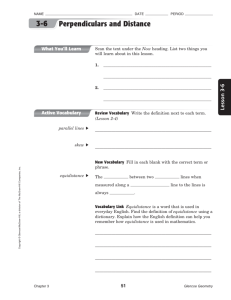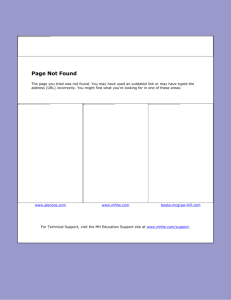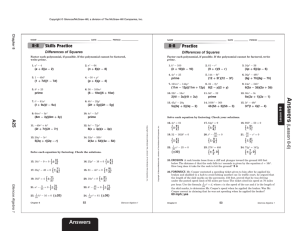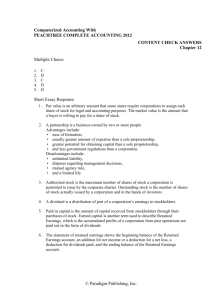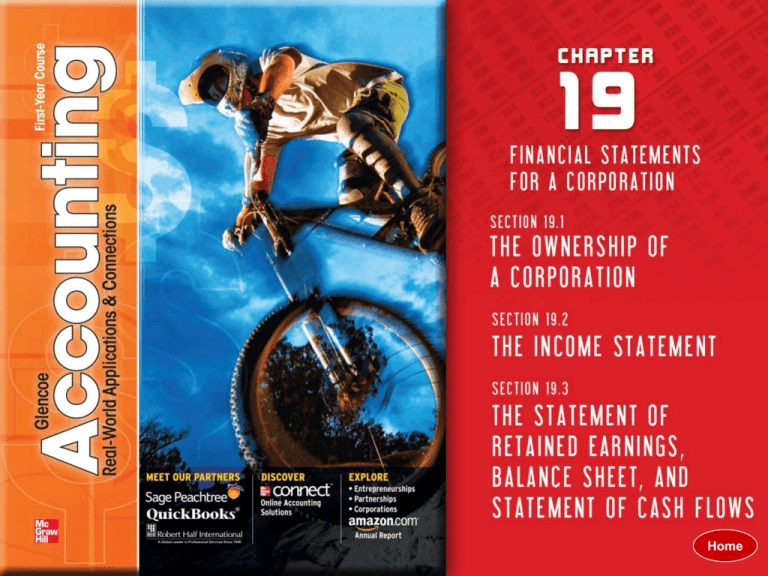
Home
Owner’s equity in a corporation is called
stockholders’ equity. A merchandiser’s income
statement has a Cost of Merchandise Sold
section, and a corporation’s income statement
shows income tax expense. Additionally, a
corporation prepares the statement of retained
earnings, the balance sheet, and the statement
of cash flows.
Home
Glencoe Accounting
Copyright © by The McGraw-Hill Companies, Inc. All rights reserved.
Explain how to record ownership of a corporation.
Explain the relationship between the work sheet and the financial
statements for a merchandising corporation.
Explain how a corporation’s financial statements differ from a sole
proprietorship.
Analyze the financial data contained on the statements.
Prepare an income statement, statement of retained earnings, and
balance sheet.
Describe the statement of cash flows for a merchandising corporation.
Home
Glencoe Accounting
Copyright © by The McGraw-Hill Companies, Inc. All rights reserved.
Section 19.1
The Ownership
of a Corporation
Key Terms
Capital Stock
reliability
stockholder’s equity
relevance
retained earnings
full disclosure
compatibility
materiality
Home
Glencoe Accounting
Copyright © by The McGraw-Hill Companies, Inc. All rights reserved.
Accounting for a
Corporation
Section 19.1
The Ownership
of a Corporation
A corporation may be
owned by one person or
thousands.
The ownership of a
corporation is
represented by shares
of stock.
Home
Glencoe Accounting
Copyright © by The McGraw-Hill Companies, Inc. All rights reserved.
Accounting for a
Corporation
Section 19.1
The Ownership
of a Corporation
Corporations have a
Capital Stock account
instead of the sole
proprietorship’s
owner’s capital
account.
This is a
stockholders’ equity
account that is the
value of the
stockholders’ claims
to the corporation.
Capital Stock
The account that represents the total amount of investment in the
corporation by its stockholders (owners).
stockholders’ equity
The value of the stockholders’ claims to the corporation.
Home
Glencoe Accounting
Copyright © by The McGraw-Hill Companies, Inc. All rights reserved.
Accounting for a
Corporation
Section 19.1
The Ownership
of a Corporation
Equity contributed by the
stockholders
Stockholders’ equity
must be reported
in two parts:
Equity earned through
business profits
Home
Glencoe Accounting
Copyright © by The McGraw-Hill Companies, Inc. All rights reserved.
Accounting for a
Corporation
Section 19.1
The Ownership
of a Corporation
Stockholders
contribute to equity
by purchasing
shares of stock.
This amount is
recorded in the
Capital Stock
account.
Home
Glencoe Accounting
Copyright © by The McGraw-Hill Companies, Inc. All rights reserved.
Accounting for a
Corporation
Section 19.1
The Ownership
of a Corporation
The net income earned and retained by a corporation is
recorded in the retained earnings account.
retained earnings
A corporation’s accumulated net income
that is not distributed to stockholders.
Home
Glencoe Accounting
Copyright © by The McGraw-Hill Companies, Inc. All rights reserved.
Accounting for a
Corporation
Section 19.1
The Ownership
of a Corporation
Business Transaction
On January 1 stockholders invested $25,000 in exchange for shares of
stock of the corporation.
See page 556
Home
Glencoe Accounting
Copyright © by The McGraw-Hill Companies, Inc. All rights reserved.
Accounting for a
Corporation
Section 19.1
The Ownership
of a Corporation
Compare the Balance Sheet for a
Sole Proprietorship and a Corporation
Home
Glencoe Accounting
Copyright © by The McGraw-Hill Companies, Inc. All rights reserved.
Characteristics of
Financial Information
Section 19.1
The Ownership
of a Corporation
Who Uses Financial Information?
Managers
Stockholders
Creditors
Government Agencies
Employees
Consumers
General Public
Home
Glencoe Accounting
Copyright © by The McGraw-Hill Companies, Inc. All rights reserved.
Characteristics of
Financial Information
Section 19.1
The Ownership
of a Corporation
information to be compared
from one period to another
Comparability
Allows
the comparison of information
between businesses
comparability
Accounting characteristic that allows the financial information to
be compared from one period to another period; also allows the
comparison of financial information between businesses.
Home
Glencoe Accounting
Copyright © by The McGraw-Hill Companies, Inc. All rights reserved.
Characteristics of
Financial Information
Section 19.1
The Ownership
of a Corporation
What Is
Reliability?
reliability
A characteristic requiring that accounting information be
reasonably free of bias and error.
Home
Glencoe Accounting
Copyright © by The McGraw-Hill Companies, Inc. All rights reserved.
Characteristics of
Financial Information
Section 19.1
The Ownership
of a Corporation
What Is
Relevance?
relevance
An accounting characteristic requiring that all information that
would affect the decisions of financial statement users be
disclosed in the financial reports.
Home
Glencoe Accounting
Copyright © by The McGraw-Hill Companies, Inc. All rights reserved.
Characteristics of
Financial Information
Section 19.1
The Ownership
of a Corporation
What Is
Full Disclosure?
full disclosure
Accounting principle requiring a financial report to include
enough information so that it is complete.
Home
Glencoe Accounting
Copyright © by The McGraw-Hill Companies, Inc. All rights reserved.
Characteristics of
Financial Information
Section 19.1
The Ownership
of a Corporation
What Is
Materiality?
materiality
An accounting guideline stating that information
considered important (relative to the other information)
should be included in financial reports.
Home
Glencoe Accounting
Copyright © by The McGraw-Hill Companies, Inc. All rights reserved.
A Corporation’s
Financial Statements
Section 19.1
The Ownership
of a Corporation
A merchandising corporation can
prepare four financial statements:
The Income Statement
The Statement of Returned Earnings
The Balance Sheet
The Statement of Cash Flows
Home
Glencoe Accounting
Copyright © by The McGraw-Hill Companies, Inc. All rights reserved.
Section 19.2
The Income Statement
Key Terms
net sales
selling expenses
net purchases
administrative expenses
gross profit on sales
operating income
operating expenses
vertical analysis
Home
Glencoe Accounting
Copyright © by The McGraw-Hill Companies, Inc. All rights reserved.
The Income Statement
Section 19.2
The Income Statement
Five Sections of the Income Statement
Revenue
Cost of Merchandise Sold
Gross Profit on Sales
Operating Expenses
Net Income (or Loss)
Home
Glencoe Accounting
Copyright © by The McGraw-Hill Companies, Inc. All rights reserved.
The Income Statement
Section 19.2
The Income Statement
The Revenue Section Reports the Net Sales for the Period
See page 561
net sales
The amount of sales for the period less any sales
discounts, returns, and allowances.
Home
Glencoe Accounting
Copyright © by The McGraw-Hill Companies, Inc. All rights reserved.
The Income Statement
Section 19.2
The Income Statement
Calculating the Cost of Merchandise Sold.
Computing the cost of merchandise sold requires two steps:
Determine the cost of all
merchandise available for sale
Calculate the cost of
merchandise sold
Home
Glencoe Accounting
Copyright © by The McGraw-Hill Companies, Inc. All rights reserved.
The Income Statement
Section 19.2
The Income Statement
Calculating the Cost of Merchandise Available for Sale
Add Net Purchases to the Beginning Inventory Amount.
net purchases
The total cost of all merchandise purchased during a period,
less any purchases, discounts, returns, and allowances.
Home
Glencoe Accounting
Copyright © by The McGraw-Hill Companies, Inc. All rights reserved.
The Income Statement
Section 19.2
The Income Statement
Calculating the Cost of Merchandise Sold
See page 563
Home
Glencoe Accounting
Copyright © by The McGraw-Hill Companies, Inc. All rights reserved.
The Income Statement
Section 19.2
The Income Statement
The gross profit on sales is the profit
made before operating expenses are
deducted.
gross profit on sales
The amount of profit made during the fiscal period
before expenses are deducted; it is found by subtracting
the cost of merchandise sold from net sales.
Home
Glencoe Accounting
Copyright © by The McGraw-Hill Companies, Inc. All rights reserved.
The Income Statement
Section 19.2
The Income Statement
Selling Expenses
Operating Expenses
Administrative Expenses
operating expenses
The cash spent or assets consumed to earn a revenue
for a business; operating expenses do not include federal
income tax expense.
Home
Glencoe Accounting
Copyright © by The McGraw-Hill Companies, Inc. All rights reserved.
The Income Statement
Section 19.2
The Income Statement
Selling Expenses
Operating Expenses
Administrative Expenses
selling expenses
Expenses a business incurs to sell or market its
merchandise or services.
Home
Glencoe Accounting
Copyright © by The McGraw-Hill Companies, Inc. All rights reserved.
The Income Statement
Section 19.2
The Income Statement
Selling Expenses
Operating Expenses
Administrative Expenses
administrative expenses
Costs related to the management of a business
(for example, office expenses).
Home
Glencoe Accounting
Copyright © by The McGraw-Hill Companies, Inc. All rights reserved.
The Income Statement
Section 19.2
The Income Statement
The federal corporate income tax
amount is presented separately on the
income statement so the income
statement shows the amount of
operating income.
operating income
The excess of gross profit over operating expenses;
taxable income.
Home
Glencoe Accounting
Copyright © by The McGraw-Hill Companies, Inc. All rights reserved.
Analyzing Amounts on the
Income Statement
Section 19.2
The Income Statement
Vertical analysis enables users to
more easily view relationships.
vertical analysis
A method of analysis that expresses financial statement
items as percentages of a base amount.
Home
Glencoe Accounting
Copyright © by The McGraw-Hill Companies, Inc. All rights reserved.
Section 19.3
The Statement of Retained
Earnings, Balance Sheet, and
Statement of Cash Flows
Key Terms
statement of retained
earnings
horizontal analysis
base period
cash outflows
operating activities
investing activities
financing activities
cash inflows
Home
Glencoe Accounting
Copyright © by The McGraw-Hill Companies, Inc. All rights reserved.
The Statement of
Retained Earnings
Section 19.3
The Statement of Retained
Earnings, Balance Sheet, and
Statement of Cash Flows
Statement of Retained Earnings
Home
Glencoe Accounting
Copyright © by The McGraw-Hill Companies, Inc. All rights reserved.
The Statement of
Retained Earnings
Section 19.3
The Statement of Retained
Earnings, Balance Sheet, and
Statement of Cash Flows
Statement of Retained Earnings
See page 569
statement of retained earnings
A financial statement that reports the changes in
the Retained Earnings account during the period.
Home
Glencoe Accounting
Copyright © by The McGraw-Hill Companies, Inc. All rights reserved.
The Balance Sheet
Section 19.3
The Statement of Retained
Earnings, Balance Sheet, and
Statement of Cash Flows
The balance sheet reports the balances of all
asset, liability, and stockholders’ equity
accounts for a specific date. The assets are
listed first, followed by the Liabilities section
and the Stockholders’ Equity section.
Home
Glencoe Accounting
Copyright © by The McGraw-Hill Companies, Inc. All rights reserved.
The Balance Sheet
Section 19.3
The Statement of Retained
Earnings, Balance Sheet, and
Statement of Cash Flows
The Starting Line’s
Balance Sheet
Home
Glencoe Accounting
See page 570
Copyright © by The McGraw-Hill Companies, Inc. All rights reserved.
Analyzing Amounts on the
Balance Sheet
Section 19.3
The Statement of Retained
Earnings, Balance Sheet, and
Statement of Cash Flows
Horizontal analysis uses dollar
amounts expressed as
percentages to compare the
same items on financial
statements for two or more
accounting periods or dates.
A base period is usually used
for comparison.
horizontal analysis
The comparison of the same item(s) on financial statements for two
or more accounting periods or dates; used to determine changes
from one period to another.
Home
Glencoe Accounting
Copyright © by The McGraw-Hill Companies, Inc. All rights reserved.
Analyzing Amounts on the
Balance Sheet
Section 19.3
The Statement of Retained
Earnings, Balance Sheet, and
Statement of Cash Flows
Horizontal analysis uses dollar
amounts expressed as
percentages to compare the
same items on financial
statements for two or more
accounting periods or dates.
A base period is usually used
for comparison.
base period
A period, usually a year, that is used for
comparison.
Home
Glencoe Accounting
Copyright © by The McGraw-Hill Companies, Inc. All rights reserved.
The Statement of
Cash Flows
Section 19.3
The Statement of Retained
Earnings, Balance Sheet, and
Statement of Cash Flows
The Statement of Cash Flows
Shows Cash Inflows and Cash Outflows
cash inflow
Receipts of cash.
cash outflow
Payments of cash.
Home
Glencoe Accounting
See page 573
Copyright © by The McGraw-Hill Companies, Inc. All rights reserved.
The Statement of
Cash Flows
Section 19.3
The Statement of Retained
Earnings, Balance Sheet, and
Statement of Cash Flows
Cash Flows from Operating Activities
To determine operating cash inflows
and outflows, the income statement
and balance sheet amounts are
converted to the cash basis of
accounting.
operating activities
Business activities involving normal
business operations.
Home
Glencoe Accounting
Copyright © by The McGraw-Hill Companies, Inc. All rights reserved.
The Statement of
Cash Flows
Section 19.3
The Statement of Retained
Earnings, Balance Sheet, and
Statement of Cash Flows
Loans the business makes
Payments received for loans
Investing
Activities
Purchase and sale of plant assets
Investments
investing activities
Business activities involving investments
and plant assets.
Home
Glencoe Accounting
Copyright © by The McGraw-Hill Companies, Inc. All rights reserved.
The Statement of
Cash Flows
Section 19.3
The Statement of Retained
Earnings, Balance Sheet, and
Statement of Cash Flows
What Are
Financing Activities?
financing activities
Business activities involving debt and
equity transactions.
Home
Glencoe Accounting
Copyright © by The McGraw-Hill Companies, Inc. All rights reserved.
The Statement of
Cash Flows
Section 19.3
The Statement of Retained
Earnings, Balance Sheet, and
Statement of Cash Flows
Typical Cash Inflows and Outflows
for the Three Activities of a Business
Home
Glencoe Accounting
Copyright © by The McGraw-Hill Companies, Inc. All rights reserved.
Question 1
Match the characteristic of financial information to its definition.
A. The information in the financial reports is complete.
B. The information is relatively free of errors and bias.
C. All information that would affect decision making is included.
D. Information from one period can be used to evaluate the information for
a different but similar period.
E. All important and relevant information should be included.
1. comparability
________
D
2. reliability
B
________
3. relevance
C
________
A
4. full disclosure ________
5. materiality
E
________
Home
Glencoe Accounting
Copyright © by The McGraw-Hill Companies, Inc. All rights reserved.
Question 2
List the steps necessary to determine the amount to report in the Cost of
Merchandise Sold section of the income statement.
Step 1:
List the amount of beginning merchandise inventory.
Step 2:
Calculate the Cost of Delivered Merchandise by adding amounts in the
Purchases and Transportation In accounts.
Step 3:
Calculate the amount of Net Purchases by subtracting the Purchases Discounts
and Purchases Returns and Allowances from the Cost of Delivered
Merchandise.
Step 4:
Add Net Purchases to beginning merchandise inventory to determine the Cost
of Merchandise Available for sale during the period.
Step 5:
Subtract the amount of ending merchandise inventory from the Cost of
Merchandise Available for sale. The result is the Cost of Merchandise Sold.
Home
Glencoe Accounting
Copyright © by The McGraw-Hill Companies, Inc. All rights reserved.
Question 3
“The wide use of computer accounting software makes the understanding of
accounting less important.” Do you agree or disagree with that statement,
and why?
Answers will vary. While computerized accounting programs make the
posting and entry of accounting transactions faster and eliminate errors in
transferring data from the journal to the ledger, this does not mean that an
understanding of accounting is less important. It can be argued that it is
more important in this case to have a sound understanding of accounting
principles to be able to follow what is happening in the business transaction
so a person can determine whether it has been entered correctly.
Home
Glencoe Accounting
Copyright © by The McGraw-Hill Companies, Inc. All rights reserved.
End of
Home


